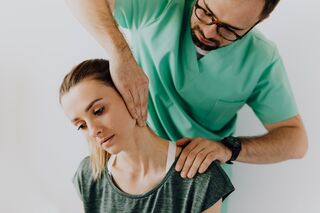Neuroscience
Why Consider Physical Therapy for Migraine With Neck Pain?
Some physical therapists specialize in chronic migraine and neck pain.
Posted November 25, 2022 Reviewed by Davia Sills
Key points
- Migraine and neck pain can be treated with physical therapy.
- Working through the complexities of this treatment can take time, which insurance companies often do not grant.
- Much of the physical therapy is "hands-on," but you must follow-up with regular stretches and exercises.
- Finding a physical therapist who specializes in migraine with neck pain is worth the effort.

I walked into Jenni’s office, as I have every week for many years now, since my headache specialist highly recommended her about 15 years ago to help me with the problems I have related to my chronic migraine. My neck pain is severe and almost daily, though, of course, it varies in intensity.
The location is always the same, though—a deep muscle on the right side of my neck along the occipital nerve. In fact, I spend three-quarters of my life pressing my thumb or middle finger into that very localized spot, something my physical therapist, Jenni Tuller, the owner of Physical Therapy Services of Rochester in Rochester, NY, regularly chastises me for, trying to teach me that doing so only really makes my condition worse. I’ve been a trying case for her!
I continue to press that spot, I stop breathing when she works on me, and I often press against what she’s trying to do. I'm a high-maintenance patient.
However, I don’t know what I would do without her. She has been a stable, unyielding supporter. She’s eminently qualified to understand the migraine—its triggers, its impact on the neck and jaw, and the exercises needed for patients to cope with the unrelenting stress on the neck by computers and phones, video games, and poor posture.
How physical therapy helps with neck pain related to migraines:
Physical therapists working with migraine patients understand that neck pain and headaches can be debilitating, affecting their ability to carry out everyday activities and lessening their quality of life. Medical experts are still uncertain whether the intense neck pain is actually part of the migraine or a warning sign of one to come.
Numerous pain-sensitive structures exist in the cervical (upper neck) and occipital (back of the head) regions. The junction of the skull and cervical vertebrae has regions that are pain-generating, including the lining of the cervical spine, the joints, ligaments, cervical nerve roots, and vertebral arteries passing through the cervical vertebral bodies (American Migraine Foundation).
A 2020 review of studies notes there are two main approaches of physical therapy that may be beneficial for migraine relief:
- Addressing injuries to the muscles, nerves, tendons, joints, cartilage, and spinal discs
- Addressing posture and inner-ear-related balance issues (Carvalho, GF et al.).
Every patient is unique and requires a tailored approach to treatment. However, some common interventions may involve manual therapy, including soft tissue manipulation to tight muscles and joint mobilizations to stiff joints. Your therapist will also educate you on which exercises will help you and which activities to avoid or modify.
The therapist will also show you exercises specifically tailored to address the symptoms related to the condition.
These may include:
- Strengthening your deep neck flexors and muscles around the shoulder blades to help reduce neck tension
- Stretching the upper trapezius, levator scapulae, scalene, and pectoral muscles
According to a study by Jull and Richardson, 72 percent of patients had achieved a reduction of 50 percent or more in headache frequency at the 12-month follow-up, and 42 percent of patients reported 80 percent or higher relief of some sort. These manipulative maneuvers stimulate neural inhibitory systems at various levels in the spinal cord and activate descending inhibitory pathways. However, physical therapy may initially worsen the headache. Therefore, treatment should be slowly advanced to include gentle muscle stretching and manual cervical traction (Al Khalili Y).
Ultimately, Jenni has taught me, after long periods of attempts, that part of the treatment lies with me; we must be a team in this part of my migraine treatment. I have to do my part. Your physical therapist will provide you with personalized exercises depending on your specific limitations and capabilities; it's up to you to perform them at home to help take control of your symptoms.
Jenni Tuller declares:
"Working with chronic migraine patients is extremely difficult because of the many barriers they face. In addition to identifying migraine triggers and resulting musculoskeletal changes, these patients have often been met with disbelief from other medical practitioners, friends, family, and employers, and need significant emotional support and education.
Breaking through these layers to improve muscle spasms, joint stiffness, and nerve irritation often takes time that insurance companies don't always afford. However, given the time and technique, PT can be extremely helpful in managing the triggers of migraine that stem from the neck" (Tuller).
What can we do to help ourselves?
One exercise that is helpful for most people is chin tucks! This exercise is a great tool to help ease neck pain and headaches because it encourages a more neutral neck position, which reduces tension and stiffness. It is imperative that you first learn how to do them correctly from your physical therapist.
Please find a PT that specializes in migraine and neck-related issues. I’ve been blessed and want you to be, as well. You may have to try out two or three to find someone who specializes in this area and/or stays current with migraine treatment. The search is worth it!
References
Al Khalili Y, Ly N, Murphy PB. Cervicogenic Headache. [Updated 2022 Oct 3]. In: StatPearls [Internet]. Treasure Island (FL): StatPearls Publishing; 2022 Jan-. Available from: https://www.ncbi.nlm.nih.gov/books/NBK507862/
American Migraine Foundation, Published: October 24, 2016. https://americanmigrainefoundation.org/resource-library/cervicogenic-he….
Carvalho GF, Schwarz A, Szikszay TM, Adamczyk WM, Bevilaqua-Grossi D, Luedtke K. Physical therapy and migraine: musculoskeletal and balance dysfunctions and their relevance for clinical practice. Braz J Phys Ther. 2020 Jul-Aug;24(4):306-317. doi: 10.1016/j.bjpt.2019.11.001. Epub 2019 Nov 29. PMID: 31813696; PMCID: PMC7351966.https://www.ncbi.nlm.nih.gov/pmc/articles/PMC7351966/
“Does Physical Therapy Treat Migraine?”Healthline.https://www.healthline.com/health/migraine/physical-therapy-for-migraine
Tuller, Jenni, PT, MS, Cert. MDT. Personal Interview. November 2022.




